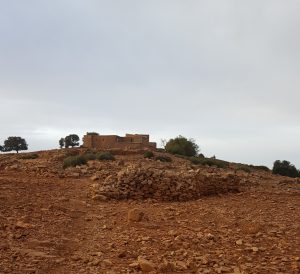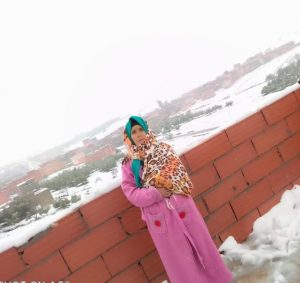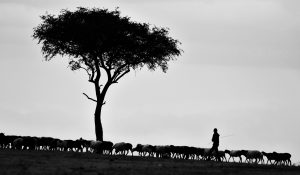These tales are introduced by Lhoussain Simour. They are part of MULOSIGE’s Amazigh Literature in Translation Project.
Introduction to the Tamazight Tales
These tales, among a dozen others, were recounted to me at various times; first by my late grandmother and then by my mother, Fadma Tainsirt. When I asked her about recording the tales for research purposes, she was extremely surprised and started laughing because she took it for a joke. When I kept explaining and insisting, she asked if I really believed that these would be appreciated, since, according to her, she “might be ridiculed when people read or listen to them.” These tales, she assumed, are “worth nothing and the people of today can no longer be interested in such old-dated and forgotten stuff.”
Going back in time, to my early years, the most delightful moments, full of intense suspense, unlimited yearnings and unbridled emotions, were ultimately those on dark-cold gloomy evenings, when the family gathered after dinnertime, around the fireplace, to listen to a storyteller from one of the family members, usually a mother or a grandmother reputed for their talent and skills in the art of narration. These tales, as I understood later, were memorised and handed down by generations of mothers, grandmothers and great-grandmothers around my village, in the Azilal plateaux and mountains.

Fadma’s home, courtesy Lhoussain Simour (2018)
As children, we were often mesmerised by the incredible events of these tales; sometimes these were long stories with unexpected happenings, recounted in a manner that would first take our breath away and, then, lull us to sleep. For the adults themselves, these stories were a momentary relief from the long days of hardship in the fields. As I grew up, I became aware that these tales are imaginatively crafted and textually threaded. They stand as invaluable pieces of oral literature, a treasure to be retrieved and saved from the retrospective forces of oblivion and amnesia. Hence, the idea of publishing these tales stems from the urgent need to preserve and perpetuate the tradition of storytelling from different parts of a Morocco that finds itself at the crossroads of cultural diversity, identity formation and nation-making.
In Morocco, Tashelhit, Tamazight, and Tarifit, the main linguistic and cultural variations of “Berber” identity, furnish the cultural mosaic of the country and, together with the Arabic language and identity, constitute to varying degrees the thriving components of Moroccanness. It is also of paramount significance to mention that various identities and cultures have contributed to the linguistic and cultural diversification of the country for many centuries now. Besides Arabic and “Berber,” Judeo-Arabic, Judeo-Amazigh and Judeo-Spanish languages, Moroccan Jewish identity, French and Spanish languages, the descendants of black sub-Saharans with distinct cultural practices, the descendants of the Moriscos and the Hassani Sahraoui heritage, bestow the country with plurality. While such identities and languages have retained their singularity in a noticeable way, cultural creolisation has also shaped Moroccan collective imagination through rites of passage, storytelling, folktales, and temporary festive moments in the communities’ life.
It is incontestable that folktales, as an essential marker of cultural identity and a defining signifier of “low” culture, are a fundamental cultural component of a country’s intangible assets that are threatened by the forces of modern technology and globalisation. In Morocco, such assets have so far received little recognition in academic circles, although there lately have been a few tentative calls for, and efforts towards, the preservation and promotion of oral tales as a strategy to save intangible cultural heritage from vanishing. Most folktales have certainly now fallen into neglect at least in my region; although, surprisingly, they used to play a significant role in family entertainment, religious morality, cultural values, social norms and codes of conduct. They circulated and transmitted shared values and collective experiences of the community years before the electrification projects and the arrival of television and internet in the remote mountainous villages of Morocco.
Bound up with the folktale’s potential for disseminating the community’s strong sense of belonging, social pride, distinctiveness and the affinities of kinship, is the idea of cultural identity and difference. Cultural identity is delimited by and inscribed in the context that has produced these tales. Reflecting on the opening of each tale, we might say that they are very old tales with considerable references to history. Each tale starts with “Nanac nanac adoraɣ ig rbbi dayt nanac ɣir mcac nnan ɣzan nɣak nnan ɣnan” (They once said, may God keep us from the tattlers unless they are raiders or wealthy). As I interpret it, this opening, which is grounded in past events, vibrates with the hint of a poetic image in which the sacred and the profane coalesce. Reducing it to “once upon a time” as is the case with most tale openings in English might delay our understanding of what the text means or dismiss the historical context(s) where the tales were born. In a recent discussion with the story-teller, she contended that “ɣzan” means “well-established” and “ɣnan” means “wealthy.” In pushing the meaning of “ɣzan” further to associate it with “ghazw,” a word borrowed from Arabic, and which stands for “invasion,” we may venture to say that we are confronted with a specific historical context laden with tribal raids, jihad wars, piratical activities in the Mediterranean and the Atlantic, and so on, whereby the return of victorious raiders or the return of Muslim corsair-galleys with captives and wealth were celebrated.
Very telling also is the closing statement of each tale. The story comes to an end when this statement is uttered: “Safi hat lhdns dinaɣ safi tanaɣ zrixtn g cert ddoɣd g lhna” (Thus ends up my story, from the wicked may it be kept; in peace shall I find my path). It declares the storyteller’s return from a magical journey that must be understood as a momentary escape to an unreal world of mysteries laden with both wickedness and chivalrous achievements. The storyteller and the listeners thus become aware that they have been taken to a fictional universe, albeit one constructed on familiar characters and settings that detach them from reality and immerse them in a world of fantasies, dreams and desires.
These tales are of Amazigh background from the Atlas Mountains, and Amazighness in these tales encompasses a pristine life that is nature-bound where identity is continually refashioned and informed by the exigencies and the predicaments of rural life. The tales unveil how rurality is constructed as a marginalised locus of shifting discourses about the Amazigh community at large. They invoke people’s connection to and association with the modest way of life of the peasantry, where nature turns out to be an omnipresent character, and where this pristine life nurtures imagination and demands a creative mode of narration. The rural defines itself as an exclusionary arena where ethnicity, gender and class are made clearly visible, enhancing marginalisation as a structural discourse. The bearers of this precious cultural asset are women, that is to say, the stories were mainly told and retold by mothers; meaning that the dimension of gender dimension with which they resonate endows the storyteller and her cultural identity with authority, artistic creativity and a powerful oral demeanour.
The tales involved in this project are chosen at random from a collection that Fadma Tainsirt still keeps in memory. They have been recorded, transcribed, translated, edited and reviewed. These are much longer stories that are only recalled from memory and the storyteller has left out fragments she could no longer remember, as she herself has confessed. We have tried to keep the translation as clear as possible since we were mostly concerned about the English-speaking audiences who are not familiar with Amazigh language and culture. The editing process that these tales went through focused mainly on both the rewriting and the reconstruction of the plots and on filling the few gaps that disturb the linearity of the story. In fact, the stories in this collection have gone through uneasy moments of textual reconstruction that targeted narrative coherence and consistency; yet, and certainly to a larger degree, the most tedious part has been during the transcribing process into the Latin script. The translator’s undeniable efforts have currently allowed us to view the stories as transparent and accessible readable material that has respected the storyteller’s speech patterns all the way through. Thanks also to his mastery of the various variants of Moroccan Amazigh language, we now have the Tifinagh version of “Zadraqa the Ruling Bird,” a transcription that will definitely enhance the plurality of the Amazigh cultural landscape for readers interested in oral literature across geographies.

Fadma Tainsirt
The Storyteller: Fadma Tainsirt
Fadma Tainsirt was born in Ighil in the mountainous outskirts of Azilal in central Morocco, a few miles away from the Ouzoud waterfalls. Unfortunately, neither she nor her mother could tell exactly when she was born, as the regions’ households never cared about registering their newly born children until quite recently, mostly because of the conditions of life, poverty and, mainly, because of illiteracy. She is a mother of eight children, three of whom died early because of unhealthy delivery conditions. Those saved came just “by the grace of God,” as she often says. She never went to school and the only language she understands and speaks is Tamazight. She has spent her life raising her children and caring for her home, which she still shares with her husband’s family. Besides storytelling, singing and reciting Amazigh poetry, she is a really talented carpet weaver. Her tattoos, her facial traits and her radiant gaze still stand as witnesses to her incredible intelligence, generosity and on-going sufferings. She is a never-ending Amazigh tale herself.
The Tales
Click on the description of each story to access the original version, the English translation and the audio version.

The Witty Shepherd
“The Witty Shepherd” is a funny story that recounts the capricious ideas of a supposedly gullible shepherd, named S’ayed, who is tasked by his authoritative uncle to look after the cattle and carry out other menial tasks for the family. The discourse about power and resistance is at the heart of the story. We are confronted with a character who, far from being easy to fool, is witty enough to overturn the edifice of authority by wresting himself from submissiveness and subjugation. More significant is how the shepherd manages to put together a game that thwarts and mocks the workings of authority by entangling the uncle in schemes that have initially been planned against him. Power, hence, is immediately re-appropriated and instead of being offended or defeated, the shepherd defensively rearticulates and manipulates the scheme to turn it against its source, strategically reversing the game of surveillance to allow the shepherd enough space to thrive. The ability of S’ayd to break through the discourse of power is enacted through different situations that are plotted against him; yet, all that the uncle and his family get is a cheerful playfulness, which subverts the authority into delightful jokes.

Mlalija, the Orphaned Princess
“Mlalija, the Orphaned Princess,” a story where hope and despair coalesce together, is constructed around a captivating plot that triggers the listener’s feelings of graceful confusion, smooth frustration, and uncertain desires geared towards creating a rewarding horizon of expectations. It takes us into a supernatural world with magical effects, peopled by fantastical creatures embarking on a journey that propels the tale towards its happy ending. It is a story with the inevitable consequence of happiness whereby the protagonist is celebrated and the villain, a witch, is doomed to be maligned and defeated. The protagonist endures a threatening situation all the way through and remains ultimately hopeful within a narrative that prompts the listeners to stay alert to the events until the end. Mlalija is defined in the story through her gendered subjectivity that conjures up images of defiance, tactfulness and resolution. Her powerful presence in the narrative lies in her ability to free herself from the clutches of sorcery and save herself from the dominion of witchcraft and its unpredicted outcomes. In listening to this story, one is mostly mesmerised by the enchanting textual refrain of the witches asking to be lifted up the tower by Mlalija’s long-knotted hair; part of which will enflame the king’s curiosity and bring the denouement of the tale that will later permeate the listeners with textual moments of relief when the orphaned girl is saved.

Fawdent, the Unwanted Sister
The tale about “Fawdent, the Unwanted Sister” has different versions and is recounted in numerous ways. One of the versions that is commonly told is that Fawdent, the protagonist, was born to her father’s second wife, not his first. Out of uncontrolled jealousy, the first wife, who had been expecting a girl but who delivered boys, wants to get rid of the second wife’s daughter – Fawdent – and, therefore, concocts a plan, together with Mimouna the slave, to send the stepdaughter to be eaten by a monster. Yet, no matter how the versions might grapple or clash with one another, the version here is what the storyteller has most recently recorded. This version entraps the narrative in a patriarchal discourse with a knot of contradictions and inconsistencies. The boys have left for fear of having a newly born sister; yet when they meet together, the unwanted sister turns into a symbol of unbounded filiation as she has run into danger in trying to find her brothers. The brothers’ scheme, unexpectedly, fades away as they come to understand how daring their sister is. The narrative, thus, allows for deeply rooted ideas on gender limitation in the rural setting to be challenged and disrupted by the audacious demeanour of the sister. Furthermore, the patriarchal discourse within which the brothers are entrapped is also dismantled by the noble values she encapsulates.

Zadraqa, the Ruling Bird
“Zadraqa, the Ruling Bird” takes us to the kingdom of birds with a wonderful tale reminiscent of the fable genre wherein two birds are almost personified and acquire a physical and spiritual presence in the narrative. In this story, the birds turn into emblematic characters with the unrestricted power of bringing the listeners back to a real world permeated by challenges, hardship and predicaments. Very significant in this tale is how the storyteller, who departs from a mere narrative event, assembles various threads of the story to construct a universe of turmoil, desires and an unfinished quest for deliverance from loss and pain. Zadraqa, out of an unexplained feeling of control and dominance, breaks the law of nature, betrays the nest’s owner, and sits forcibly on eggs that are not of its breed. Thus, this unusual textual thread drives the owner of the nest into a series of enigmatic requests that it needs to abide by and fulfil in order to recover the nest. Through this captivating story, the storyteller shows immense skills in the art of storytelling while narrating with wonder and enchantment the range of requests that emanate from different sources purporting to help the bird. She also excels in playing with the tale’s adjacent events in a delightful manner that both inflames the narrative with breath-taking moments of suspense and arouses feelings of excited uncertainties. On a journey with the listeners, the narrator swings back and forth, like a pendulum: going back to the story’s beginnings and then moving ahead with the next request whenever the expectations of the unfortunate bird fail to be satisfied.


Leave A Comment